Porsche 911 Buyers guide (996 series) video transcript
Watch the video here
Hi I am Adam Caulfield I’m the director of Cavendish porsche, based in Nottingham. We are an independent Porsche specialist.
I’ve been buying and selling Porsches now for about eight years. I’ve been an avid fan of Porsches since my mid-twenties.
The great thing about the 996 right now is that it’s an affordable entry to 911 ownership, it’s a great piece of engineering despite some of the things you may have read on the internet.
1. Exterior checks
The first thing I always start with is the exterior I walk around the car i look at the general condition of it. How does it look like? What’s the first impression that it gives me? Does it look like a clean example?
Then I look a little closer. Are there any signs of of paint work? It might have been painted in the past, which is fine, most cars have had paint at some point in time. However, if it has had it has it been done sympathetically? Are the gaps between the panels, are they even throughout?
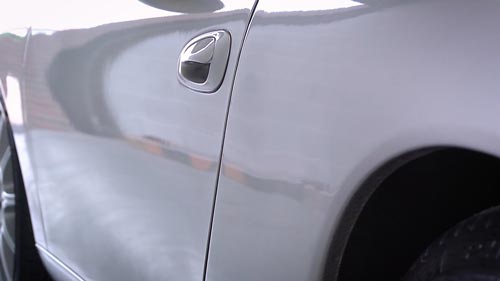
Carefully check the condition of the cars bodywork
What’s the tread on the tyres like? Put your finger in, feel for the wear bar. See how much tread you’ve got left on your tyres. Look through the alloys, look at the brakes. Is there a big lip on the disks? Do the pads look heavily worn? All indications of how well the car’s been maintained. It’s important to check the condition of the alloys obviously it’s difficult to see if it’s buckled, you’ll feel this on the test drive but visually, look at the condition of it. Is there any scuffs, scrapes, any corrosion on the alloys? Are they split rim? Are they polished? Because polished alloys are expensive to refurbish, where as painted alloys are a lot cheaper. If it’s just the faces, you can budget on about 50 pounds per alloy to put it right. If it’s a polished alloy, then it needs to be sent off and diamond cut at a specialist and this can be very very expensive. So make sure you’re happy with the condition of the alloy and make sure there’s not too much corrosion on the alloy as well.
2. Interior checks
The interiors can, funny enough, be one of the more expensive things to rectify if they’re in shoddy condition if you’re buying a car that has a light colour interior for example, such as a grey colour, they don’t tend to wear as well, and are certainly harder to keep up with.
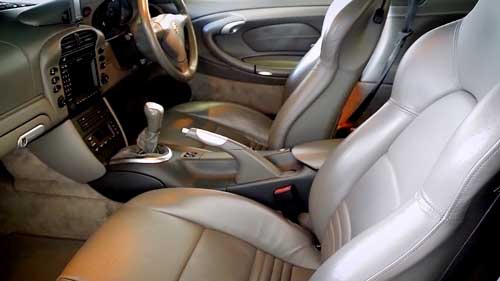
Shabby interiors on a Porsche 996 can be expensive to put right
So what does it look like? Does it look shabby? Are you happy with it? Are there any scratches? Are there any tears or wear to the bolsters? This can be quite expensive to to rectify.
Then once I sit in the cabin, I just do some simple tests. Some common-sense things really. Do the windows operate? The indicators, the stereo, sat-nav if it has one. Just check the electrics, just go through the car, make sure everything works as it should.
3. Service history checks
Check through the service history, check through its book make sure is it an original? Open it up look on the first page see if it’s got the factory sticker at the front. If it has it will have the V.I.N. number clearly printed across it.
Check that with the V.I.N. number on the windscreen. Then turn to the stamps, has the car been serviced to manufacturers specification? If it’s an early Porsche 996 it has to have a minor and a major every 20,000 miles or two years, whichever comes first. We do it alternate, but then it needs to have an annual service on top of that.
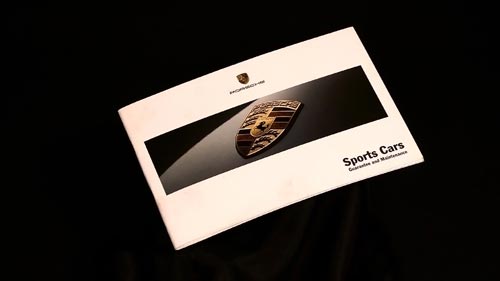
Carefully check the service history
If it’s a facelift, from 2002 onwards, you don’t have to bother with the annual service but it needs to have been serviced at least every two years or twenty thousand miles, whichever comes first.
Make sure those stamps exist, because that can have a massive impact on the car’s value. If it has its old MOT’s and some some old service invoices, all the better.
Anything that can back up its service history, will help when you eventually come to sell on the car.
4. Mileage
Mileage on a Porsche 996 will have a real impact on its value.
I wouldn’t necessarily be to put off by high mileage car as long as there is strong evidence that it’s been well maintained throughout its life and all the things
that could wear through time, have been changed at some point. Such as a clutch, suspension components, brakes, tyres.
Common-sense items, just make sure that they’ve been done, make sure you’ve done your homework and as long as it stacks up don’t be put off by a high mileage car as long as its price correctly for its miles.
5. The test drive.
A test drive will give a lot away about the car.
It’s imperative that you test-drive it. Can you get on with the car? Do you like the feel of it? It might be the first time you’ve ever driven a 996 or a
Porsche for that matter, but when you do there’s a set number of things you need to be looking out for.
Firstly, how does the car handle? Does it pull to the side? Is it driving nice? If it’s a manual does it go through the gears smoothly? There’s no crunching, there’s no notchy-ness.
What does the clutch feel like if it’s a manual? Is it biting high? Does it feel heavy?
Can you hear at low speeds any knocking or any creaking? Because if you can especially if you go over say speed bumps that’s a sign that could be a problem with the suspension.
All these little indicators are telling you that there are issues and there are things that need to be looked out for, need to be attended to to make the car right.
So a test drive can give a lot of way about the car.
6. Porsche 996: Temperature gauge checks
When the car is up to temperature, so you need to make sure you’ve given it a good old drive, driven it for a while, the coolant guage should be roughly at twelve o’clock. If it’s running any hotter than that then there’s an issue with the coolant.
On the oil pressure, when it’s up to temperature and it’s at idle you really want it to be between one and two bars. When you’re at about 4,000 revs you want it to be four to five bars.
What you’ll notice when you first turn the car on and the engine is cold that the pressure will run higher, that’s fine, that’s normal it’s because the oil is thicker and it thins off as the engine gets hotter.
7. Manual and Tiptronic gearbox checks
When checking the gearbox and clutch on a manual vehicle, you always want to check to see it goes into each gear nicely, smoothly with no crunching. The manual gearboxes were prone for synchros two to wear, so particularly check the second gear, make sure that it goes in well. With your clutch, if it’s heavy that doesn’t necessarily mean the clutch is wearing out, it just means it can be old and it’s got a lazy pressure
plate.
You want to check for how high the clutch is biting as the higher it bites, the more worn that clutch is.
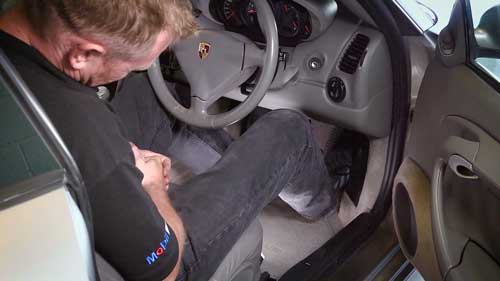
Porsche 996 – check how high the clutch bites
Again, you know you’re into eight hundred to a thousand pounds for a clutch replacement so it’s something you really want to do.
On a Tiptronic car, obviously there’s no clutch to be concerned about, so that’s one thing that we don’t have to worry about. But make sure again that it goes through the gears ok.
Look on the dash because it’s automatic and make sure it goes through all the gears. It’s quite normal to start off from 2nd gear from a standing start it’s not a fault, it’s a characteristic of the gearbox.
The Tiptronic gearboxes are pretty robust and don’t usually have any major issues but they can be prone to leaking, so again stick your head under the car if you can, have a good look at that gearbox and just see if there’s any leaks there. This can be quite an expensive repair, depending where the leak is.
8. Air-conditioning checks
Another thing to check with a 996 is the air-conditioning. They all have it so check that it chills down, it gets nice and cold. Sit in the cabin, put it down onto its highest setting on the air-con and it should be ice-cold. If it’s not ice cold, then there is an issue that needs remedying.
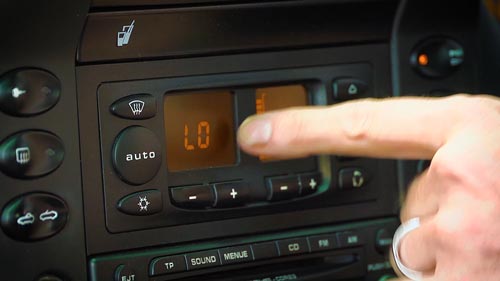
Porsche 996 – air conditioning checks
A lot of people tell you it’s re-gassing but it’s very seldom you have to re-gas the system on Porsches, it usually means there’s a leak.
Nine times out of ten, the leak exists in the condensers. Now they’re located at the front of the vehicle. There’s two, one either side of the vehicle.
What you need to do, is look at the front bumper, look at each corner, look at the opening and you’ll see what looks like a little radiator. That’s your condenser for your air-con.
Can you see any signs of fluid? Is it leaking? They are prone to hold the leaves in that area and the leaves rot through the bottom, so you find they leak at the seams.
Or stone chips, stone chips can hit the radiators and burst them. If that’s the case, again you’re looking at a few hundred quid to replace the condensers and re-gas the system.
9. Exhaust checks
Check the mufflers, the exhaust mufflers at the back of the vehicle in each corner.
(Exhausts on a Porsche 996) are a clamshell design, they’re essentially welded together and the seams are prone to rotting.
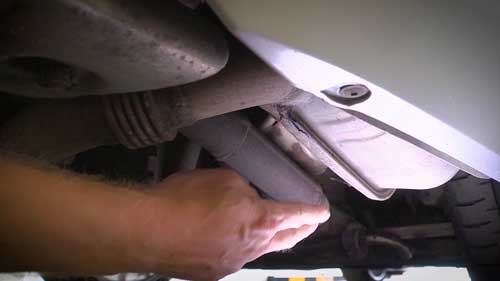
Check the exhaust back box (clamshells) for signs of corrosion
So just look at the conditions of the seams, see if have rotted through because once they split and they blow they are very expensive to put right.
10. Porsche 996 Cabriolet and 996 Targa roof checks
When looking at a 996 cabriolet and you are checking the roof, you need to make sure the operation works properly, does it open properly? Does the oyster shell lift and as it should correctly Does the roof close properly? When you first unlatch it, do the windows drop? Because sometimes the windows can fail and they don’t drop so you can’t shut the door properly.
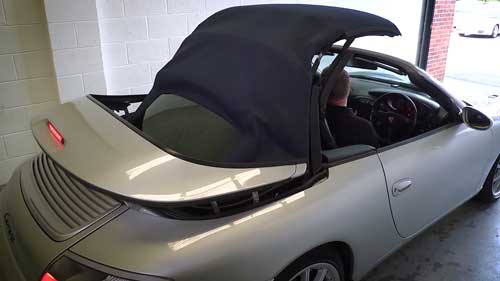
Checking the Porsche 996 cabriolet electric roof
Check for these things, as long as they work properly then all should be well.
If you’re buying a 996 targa, make sure the roof works because they can be problematic and if there is a problem with the roof they are expensive to remedy, so just make sure it opens properly. Does the blind open-and-shut correctly? Does the glass slide back all the way? And does that close properly? Are there any funny noises when its opening and shutting and also check when you’re driving the vehicle, test driving the vehicle, for the wind noise, you will get a bit more wind noise than you will with a coupe but it shouldn’t be excessive.
11. Options and upgrades
When buying a 996 the options that are on that car will reflect in its value, the more options, the more expensive the car will be.
Now consider are these options that I want? Do I need them? Because at the end of the day you’re buying it because it’s a sports car and it’s a Porsche.
Some options, such as sat-nav, cruise control, switchable sports exhaust, sports suspension. They’re very desirable but they will ultimately cost you more money because the car will be of a higher price, because it will be worth more, so do you need them?
Options are a big thing with Porsches in respect of how much the car is worth.
If you see anything on the vehicle that you think is aftermarket ask yourself you okay with that?
It might be that you are, it might be that they’ve upgraded the sat-nav, because
they’re not the best if I’m being honest with you, and they may have put an aftermarket sat-nav in. If you’re okay with it fine, you’re buying the car at the end of the day, but make sure it works and functions as it should.
Ask the customer if they have the the original part, because if they do, it’s quite nice to include that as part of the sale because one day you might want to sell this this car too and if you, at least you’re giving your future buyer the option of taking the car back to factory if they want to.
12. Porsche 996 horror stories – IMS failures
If you’re serious about buying a 996, you’ve probably read a little bit about IMS failures.
An IMS failure is essentially a baring, that over time through oil seals failing and oil contaminating the grease in the baring causes the steel barings inside the baring to collapse.
It’s very difficult to detect an IMS problem because the IMS either fails or it works. Simple as that.
The good news is, there are a lot of solutions out there that can help alleviate the problem with the IMS. Such as ceramic bearings, oil-fed IMS solutions. They’re all very well documented on the internet.
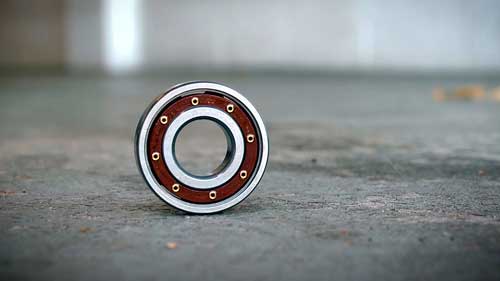
Ceramic Porsche Intermediate Shaft (IMS) baring
But to put it in perspective, the amount of IMS failures we see a year are probably 1 to 2 and we see a lot of cars.
Bore scoring
The other potential issue is bore scoring.
Again like the IMS the bore scoring, it is an issue, its thankfully something that can be remedied should it happen but again like the IMS, there’s a heck of a lot of 996’s out there that never ever have an issue so please put it in perspective.
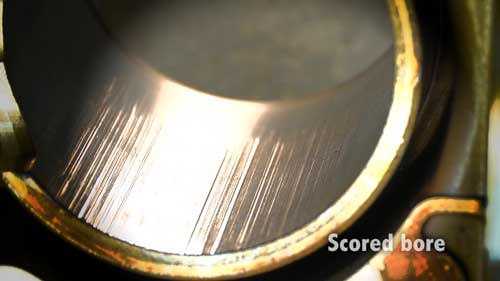
The dreaded issue of Bore scoring
With bore scoring there are a few things that you can check for without needing a specialist.
Can you hear a low-end ticking noise? Which is what you’ll get with advanced bore scoring.
Look at the back of the tailpipes, look at the left side bank. Is it sootier than the right side bank? If it is, chances are it’s picked up on a cylinder or two.
If you want to be really belt and braces about it, take it to a specialist, they can check those things for you that i’ve already mentioned plus they can do a borescope
at your request to see if any scoring exists.
Another important point to make on bore scoring, is that on the 996’s, on the GT cars and turbos they don’t suffer from it because it’s a completely different block.
Rear Main Seal (RMS) leaks
You’ve probably read about RMS leaks, now they’re not dangerous to the car, the car’s not going to blow up or do anything silly but a leak is a leak and it needs attending to.
To check for an RMS leak, stick your head underneath the back of the vehicle and try to locate where the gearbox meets the engine and where the two meet they have a seal between them that’s the RMS, the rear main seal, that’s what it stands for.
Is there an excessive amount of oil at that point? If so, that’s something that needs attending and it can be several hundreds of pounds to put right.
If there’s a little bit of misting, in all honesty it happens and it’s typical of all Porsches, you’re just looking to see how bad that leak is.
13. Porsche 996 buyers guide: Tips of the trade
Always ask the question if it has its spare key because a spare key on a Porsche is very expensive. You have to buy the head, the blade and then you have to have it coded so you can easily into well over 200 pounds to have a replacement key.
When you’re looking at a Carrera 4 there isn’t a great deal of difference, when you
first look at it to a Carrera 2. A Carerra 4S is easy because it’s a wide-body so you look at it, you can see the difference straightaway. But the differences are
subtle.
How do you know the seller hasn’t just put a 4 badge on the back of the car? People do that.
Well there’s a few things to look for. Open the front bonnet and have a look at the size of the boot it’s considerably smaller to a Carrera 2, because it needs to make room for the front diff.
Also look at the calipers, the calipers should be silver.
Familiarize yourself with the front of the Carrera 2, look on some of the websites to see what a front bumper looks like on a Carrera 2, because on a Carrera 4 it’s a slightly different style and of course the obvious is check the logbook or what you could do is you could call Porsche, ring any Porsche dealer and give them the VIN number and they will give you the the options and the make, model, and year of the vehicle.
We get many customers that come to us, they’ve bought a car and then they come to us to inspect it. They are then surprised to find there are things that need sorting. So you don’t want to do that.
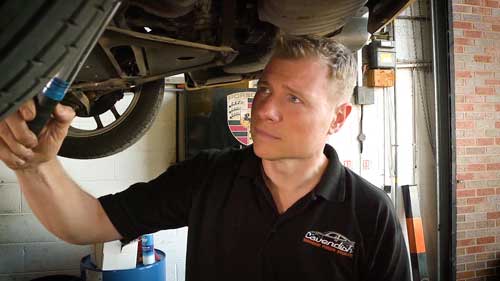
Getting a Porsche 996 inspected before buying it can really save you money!
Really the key is, put your hand in your pocket, spend a couple of hundred quid, find a local Porsche specialist, local to where the car is. Get the car to them, don’t get them to the car, because they can do a lot more by getting that car on a ramp.
Have the car inspected and it’ll save you a lot of money in the long run doing it that way, rather than the other way around.
After reading this Porsche 996 Buyer’s guide, watch the video
Disclaimer
This video and the information within it is intended for guidance purposes only. Neither carphile.co.uk or Cavendish Porsche Ltd shall be under any liability in respect of any information/views contained within this video. Please be advised to always consult a qualified Porsche specialist before making a decision to buy a car. Any prices stated should be read as a guide price only (interview August 2016).







